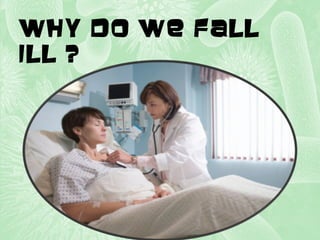
Why do we fall ill?
- 1. Why do we fall ill ?
- 2. Grandmother Dress well Reputation Insanitation Uncomfirtable Grandmother Dress well Reputation Insanitation Polluted area Uncomfortable
- 3. • ‘Health’ is therefore a state of being well enough to function well physically, mentally and socially.
- 4. • Disease – Any disturbance in the structure and /or function of any organ or part of body.
- 5. TYPES OF DISEASES • Acute disease – Some diseases last for only very short periods of time, and these are called acute diseases. E.g. common cold
- 6. • Other ailments can last for a long time, even as much as a lifetime, and are called chronic diseases. E.g. elephantiasis, tuberculosis
- 7. Comparison of damages to health by acute & chronic diseases • Common cold • Tuberculosis
- 8. Get better & become well within a week or so - short of breath - lose weight - feel tired all the time
- 9. • Prolonged general poor health if we have a chronic disease
- 10. Types of diseases • Infectious disease – Communicated from diseased person to healthy person. Caused by some biological agents / pathogens like – Viruses, bacteria, protozoan, nematodes, fungi • Non-infectious disease – Restricted only to those persons who are suffering. Diseases that are not caused by infectious agents.
- 11. INFECTIOUS DISEASES • Infectious agents • Means of spread • Organ specific & tissue specific manifestation • Principles of prevention
- 12. Infectious agents - Organisms that can cause disease are found in a wide range of such categories of classification.
- 13. Infectious agent Disease Virus Common cold, influenza, dengue fever, AIDS Bacteria Typhoid fever, cholera, tuberculosis, anthrax Fungi Many common infectious disease Protozoan Malaria, kala azar Worms worm infections, elephantiasis
- 14. Why is it important that we think of these categories of infectious agents?
- 15. As an example, let us take antibiotics. They commonly block biochemical pathways important for bacteria. Many bacteria, For example, make a cell-wall to protect themselves. The antibiotic penicillin blocks the bacterial processes that build the cell wall. As a result, the growing bacteria become unable to make cell-walls, and die easily.
- 16. Means of spread of infectious disease 1. Air born diseases Common cold, pneumonia, tuberculosis 2. Water born diseases Cholera, amoeboisis 3. Sexually transmitted diseases Syphilis, AIDS 4. Through vectors Anopheles mosquitoes – vector of malaria
- 17. Organ specific & tissue specific Manifestations After entry of microbes in our body where do they go?
- 18. Answer depends on Point of entry : • e.g. tuberculosis - caused by bacteria - entry point through Nose to lungs
- 19. • e.g. jaundice – caused by viruses – through mouth to liver
- 20. To reduce the effects of the disease :- This can be done by taking medicines to bring down the effects of the disease like fever, pain or loose motions etc. and by taking bed rest to conserve our energy. To kill the microbes This can be done by taking suitable antibiotics and drugs which kills the microbes and the disease is cured. Principles of treatment
- 21. He who has health, has hope; and he who has hope, has everything.
